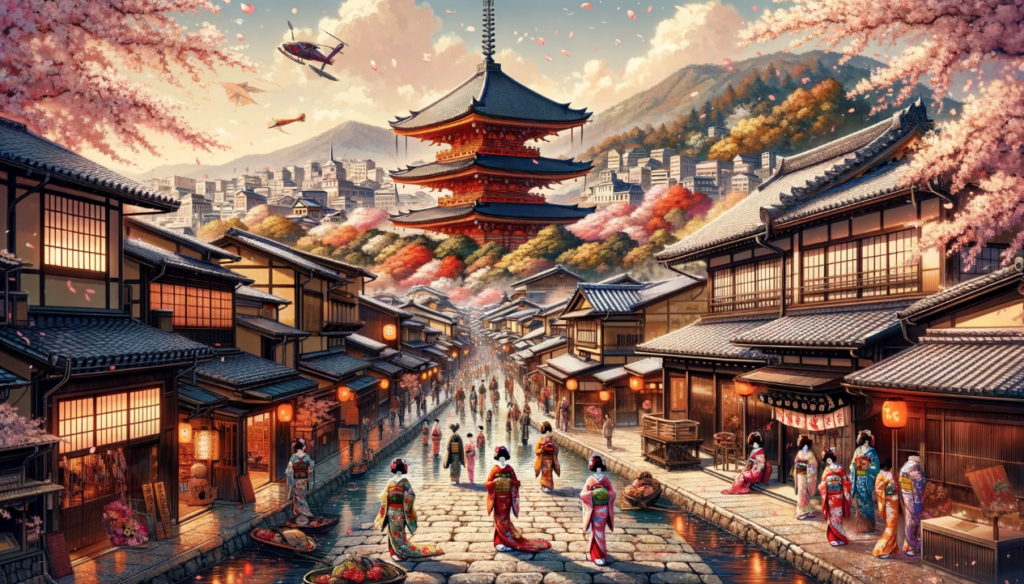
Lesson 56 Kyoto
Topic Question: What makes Kyoto a must-visit destination for those interested in Japanese history and culture?
No. 1: Introduction -First, try answering the question yourself.
The instructor will provide advice on vocabulary, grammar, and expression corrections.
Sample Answer – Let’s read aloud. The instructor will check your pronunciation and accent.Kyoto,
the heart of traditional Japan, stands as a beacon for those fascinated by the country’s rich history and vibrant culture. Once the capital for over a thousand years, its landscape is dotted with ancient temples, shrines, and gardens, each telling its own story of a bygone era. Kyoto’s preservation of traditional arts, including tea ceremonies, ikebana, and geisha performances, offers a deep dive into Japanese aesthetics and values. The city’s ability to maintain its historical essence, while simultaneously embracing modernity, makes it an essential destination for anyone seeking to understand the complexities of Japanese culture and history.
No. 2: Vocabulary Building – 5 Words to Learn and Their Meanings
Pronounce the Words Correctly (Pronunciation Training) + Make Sentences Using the Words Instantly
- Beacon (灯台, tōdai): A signal light or other device that guides or warns; metaphorically, something that attracts attention to a specific place, activity, or condition.
“Kyoto serves as a beacon for those eager to explore Japan’s historical and cultural treasures.”
- Preservation (保存, hozon): The act of maintaining something in its original or existing state.
“The preservation of Kyoto’s traditional houses and tea shops offers a window into the past.”
- Aesthetics (美学, bigaku): A set of principles concerned with the nature and appreciation of beauty, especially in art.
“Japanese aesthetics, focusing on simplicity and nature, are vividly displayed in Kyoto’s gardens and temples.”
- Essence (本質, honshitsu): The intrinsic nature or indispensable quality of something, especially something abstract, that determines its character.
“The essence of Kyoto lies in its ability to blend tradition with modernity.”
- Complexities (複雑さ, fukuzatsusa): The state of being complex; intricacy.
“Understanding the complexities of Japanese culture is made easier through experiencing Kyoto’s festivals and daily rituals.”
No. 3: Key Idiom and Example Sentences
“A picture is worth a thousand words” (一画千言) – Suggesting that a complex idea can be conveyed with just a single picture, or that an image conveys its meaning or essence more effectively than a description does.
“Visiting Kyoto’s historic sites, where each structure and garden tells its own story, truly embodies the idea that a picture is worth a thousand words.”
“In the context of Kyoto, experiencing its beauty firsthand is like viewing a living picture, conveying the depth of Japanese history and culture more effectively than words alone.”
No. 4: Discussion and Exchange of Opinions on the Sample Answer
Instructor: How do you think Kyoto has managed to maintain its historical identity despite the pressures of modernization?
Student: [Opinions of students]
No. 5: Free Discussion on the Topic
Let’s explore further into Kyoto’s role as a custodian of Japanese culture and history. How do events like the Gion Matsuri embody the city’s cultural heritage? Consider the impact of seasonal changes on Kyoto’s landscape and how they influence local customs and festivals. Additionally, discuss how Kyoto’s approach to preserving its historical sites while promoting tourism can serve as a model for cultural preservation worldwide. How are new generations in Kyoto and broader Japan engaging with traditional practices in the digital age?







